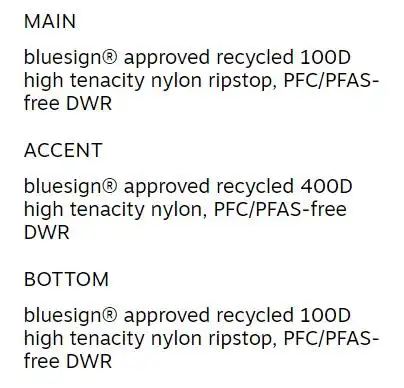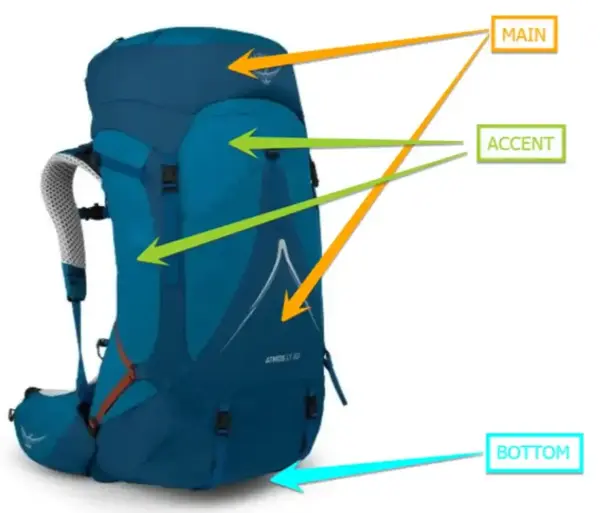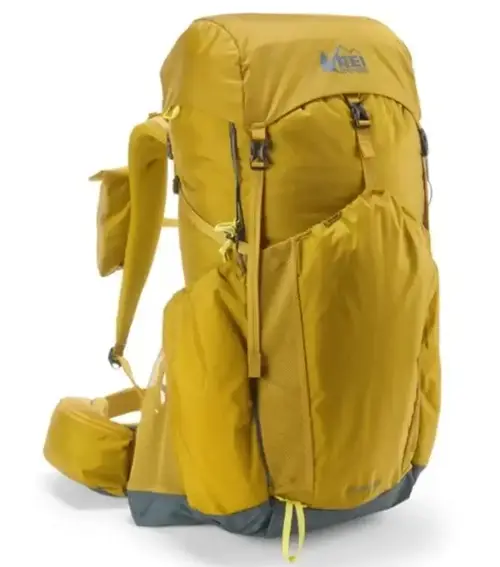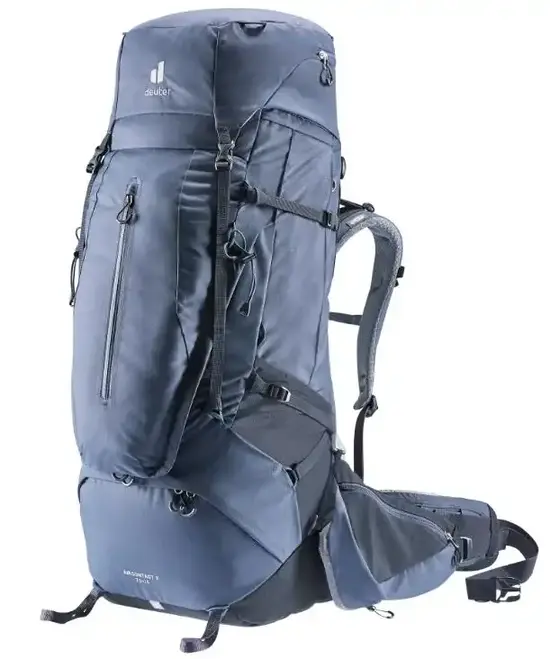Are you confused by hiking and backpacking backpacks fabric jargon? Whether you prefer ultralight or heavy-duty packs, you will find the terminology decoded here, so keep reading.
Hiking and backpacking backpacks typically have three different external fabrics used in their construction: main, accent, and bottom fabric. The bottom fabric meaning should be self-evident, but the other two may be confusing.
The main fabric is the primary material that forms the pack’s body and core structure. On the other side, accent fabrics serve as secondary materials that can add aesthetic appeal or reinforce high-stress areas. Ultralight packs frequently have only one fabric used.

Why this text
I was watching a video of a clearly experienced hiker who was comparing two high-quality backpacks of Osprey, and he was annoyed by various abbreviations and terms that were listed in specifications for the fabric of the packs.
But who would blame him when you see the terminology? To realize what I mean, it is enough to have a look in the screenshot below. This is from Osprey Exos 48 pack.

This may indeed be confusing and far from clear. As you see above, the main fabric is supposed to be 100D (here D means denier), which is not so impressive, while the accent fabric is a far more durable 400D. The same 100D is used on the bottom where it should be the strongest possible.
Why would they use a far stronger material for the secondary fabric? So, I decided to ask Osprey directly.
It took me three e-mails before they understood what I was asking. The result is the picture below. It was kindly prepared for me by a person from Osprey.

If you are curious, this is a pack from their Atmos and Aura AG LT series described here in the site in my separate text. From this picture I did understand a bit of what they mean by ‘main’ and ‘accent’ fabric, but I remained puzzled by the numbers mentioned above.
But if you visit their site, you will find out that in that particular AG LT series both the accent and main fabric is the same bluesign approved recycled 210D nylon honey comb contrast, whatever this means.
So in this series it doesn’t matter which is which, the denier value is the same in any case, and the same fabric is used.
But I remain confused regarding the Exos packs. If you know more, do let me know. When you check the same pack at REI, you will see what is shown in the picture below. They do not bother examining which is which.

But remember, sometimes the accent or secondary fabric may also be used in more exposed and high-stress areas. So the word ‘secondary’ may really be misleading, hence confusion.
By the way, REI has its own packs within their REI Co-op products, and if you follow this brand you will know that they are incredibly popular. Now, REI uses its own terminology, you can see this in the specifications of their famous REI Co-op Flash 55 Pack (and no, this is not the only color, they have it also in a beautiful Jasper Green):

They write about:
- Shell A: 100-denier recycled nylon Robic ripstop.
- Shell B: 210-denier recycled nylon Robic (high tenacity yarns).
Now, which is? You can only guess, and perhaps also feel under fingers when you touch it. Here is the pack in the video, in the mentioned green color, have a look:
A bit more about terminology
Hiking backpack’s main fabric
When discussing a hiking backpack and its fabrics, the term “main fabric” typically refers to the following:
- The main fabric is the primary material that makes up the majority of the backpack’s body. It’s the durable and often water-resistant or waterproof fabric that forms the main structure of the bag.
- Common materials for the main fabric include nylon, polyester, or a combination of both. These materials are chosen for their strength, resistance to abrasion, and ability to withstand the rigors of outdoor activities.
- The main fabric is responsible for providing the backpack’s overall durability, weather resistance, and structural integrity.
When it comes to the construction of a hiking backpack, the main fabric is essentially the backbone of the product. It’s the primary material that covers the largest portion of the pack and is fundamental to its overall resilience and functionality.
The main fabric is selected for qualities that include durability, water resistance, and weight – the triad that carries the most significance for avid hikers.
Predominantly, manufacturers choose robust materials such as nylon or polyester for the main fabric. Nylon is prized for its exceptional strength-to-weight ratio and elasticity, which means it can endure substantial loads while returning to its original shape once the weight is removed.
Polyester, on the other hand, is often favored for superior UV resistance and quicker drying times.
Other materials might include specialized fabrics like ripstop, which weave a reinforcement thread at regular intervals to prevent tears, or technical fabrics with a DWR (Durable Water Repellent) finish for enhanced weatherproofing. You have already seen this DWR in the screenshots shown above.
The selection of these materials directly impacts the backpack’s ability to withstand the test of time and nature’s unpredictability. Moreover, the texture and grade of the main fabric influence the backpack’s feel and breathability.
Both hikers’ comfort and the longevity of the gear depend on these material choices. By prioritizing a well-constructed main fabric, users are ensured a more pleasant and reliable experience on their outdoor excursions.
What does accent fabric mean?
In the case of hiking and backpacking backpacks, this term should be understood as a secondary material, usually in a different color.
This accent material is normally added for aesthetic reasons, to add contrast and depth, and to make the main fabric more prominent and distinct.
- The accent fabric is used in smaller sections or as detailing on the backpack. It is not the primary material for the main body of the bag but is strategically placed to enhance both functionality and aesthetics.
- Accent fabric might be used for pockets, straps, zippers, or other areas where additional reinforcement or a different texture is desired. It can add style to the backpack and may serve specific functional purposes.
- This fabric is often chosen for its specific properties, such as flexibility, breathability, or lighter weight, depending on its intended purpose within the design.
While the primary fabric of a hiking backpack gives it structure and resilience, the accent fabric offers both aesthetic flair and functional benefits. It’s these details that often catch your eye, setting one pack apart from another in terms of style and design.
Manufacturers typically choose accent fabrics that complement the main fabric not just visually, but in performance as well. These might include more textured materials, reflective elements for safety, or lighter, more breathable fabrics used in less abrasion-prone areas.
Accent fabric can serve a practical purpose beyond the look. You may see tougher materials in high-stress points. This adds an extra layer of durability where it’s most needed.
Another consideration for accent fabrics is the interplay with the backpack’s features, like pockets, zippers, and padding. Designers carefully select these complementary materials to enhance the overall functionality without compromising the backpack’s integrity.
Choosing your hiking backpack: a material perspective
I consider backpacks more than just storage vessels for hikers; they are a hiker’s closest companion on the trail. The materials that make up the backpack play a vital role in ensuring your gear stays protected and your journey remains comfortable.
When you’re picking out a hiking backpack, the variety of materials can be daunting. I know that deciding between the ruggedness of a main fabric and the visual appeal of an accent fabric requires a careful balance. But remember, it’s not just a fashion statement; it’s about the right fit for your outdoor adventures.
Here’s what I suggest you keep in mind: durability and intended use should guide your choice. Ask yourself, do you need a pack that will withstand heavy wear and tear, or are aesthetics more important for light trail use? Perhaps, you’re looking for a blend of both?
Consider the environment you’ll be venturing into. The last thing you want is for your main fabric to give out under the strain of rough brushes or inclement weather, or for your snazzy accent fabric to fade after a few exposures to the sun.
Focus on the main fabric for overall quality. The strength of this element is pivotal; it carries the bulk of your gear and undergoes the most stress.
Don’t disregard the accent fabric, though. These pieces are often placed strategically to reduce weight or improve comfort. Accent materials can offer a subtle boost in functionality, like increased water resistance in selected areas or added breathability.
In my experience, high-quality packs use reliable materials for both main and accent fabrics. I encourage you to pay attention to these details—read labels, ask salespeople, and go for trusted brands with proven track records.
Ultimately, a good hiking backpack is an INVESTMENT in your outdoor activities, whether you’re an occasional day-tripper or a seasoned trailblazer. Choose wisely, and your backpack will be a faithful companion for many years and miles.
Ultralight and ultra-heavy packs
I mentioned that some ultralight packs do not have such a variety of materials. You can see this in the ultralight Osprey Exos and Eja Pro backpacks. Note that they are presented here in the site in a separate text.
Those have only what they call the NanoFly 100D Nylon x 200D UHMWPE ripstop with a DWR treatment, and made without PFAS. The same material is even on the bottom. The Exos Pro 55 in the picture is one of them:

This may work if you go ultralight, without heavy load. But for extended tours and lots of equipment in a rugged terrain, you will need something stronger.
In this regard, nothing can match Deuter, their Aircontact X packs are designed for heavy loads, and the fabric is incredibly tough. The Deuter Aircontact X 70+15 pack in the picture has a combination of 330D fabric used for the body and 1000D fabric on the bottom and exposed areas.

Note that these packs are discussed here in the site in my separate text about their weight.
Final thoughts
In conclusion, whether you lean towards ultralight or heavy-duty packs, we’ve demystified the terminology to help you make informed choices.
From the backbone of the main fabric to the aesthetic and functional flair of accent fabric, we’ve navigated the intricacies of material selection.
Consider durability, intended use, and environmental factors when choosing your hiking companion. An investment in a quality backpack ensures a faithful trail companion for years to come, be it for occasional day-trips or seasoned trailblazing.
You might want to read also my text about canvas backpacks. This site is all about outdoors activities and outdoor questions and answers, and I add texts here on a regular basis, so bookmark it and keep as a reference. Please use the comment box below in the case of questions or comments.
Subscribe to my weakly newsletter and stay informed, the subscription form is given below. Thank you for reading and have a nice day.
Leave a Reply